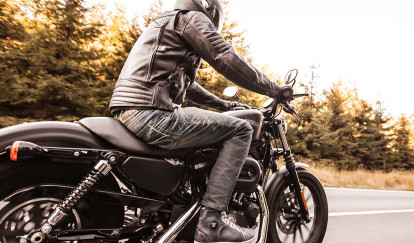
Share This Article
Nothing feels quite like the freedom of riding a motorcycle. The wind in your hair, the sun on your back, the ability to weave in and out of traffic — wait a minute, not so fast. Before you go full-on Easy Rider, remember that all the extra perks of riding a motorcycle can come at a price. The most important aspects of motorcycle riding are safety and knowing how to share the road safely with other vehicles.
Why are Motorcycles Dangerous?
We hear a lot about how dangerous motorcycles are, and that's because, generally speaking, they are more dangerous than automobiles. As any kid learning to ride a bicycle will tell you, it's harder to maintain control on two wheels than four. And if you are in an auto accident, you have no enclosure, air bags, or seatbelt to protect you. According to the Insurance Institute for Highway Safety (IIHS), there were nearly 5,000 fatal motorcycle accidents in 2016 — more than double the number from 20 years ago.
Here are six tips to encourage motorcycle safety:
1. Familiarize Yourself with Virginia Motorcycle Laws
We're not here to tell you that you shouldn't ride a motorcycle, only that you should do it as safely as possible. This means you'll have to take a few extra precautions that automobile drivers do not. First, make sure you know the rules that govern motorcyclists in Virginia because they do vary by state. Some things to keep in mind: You can ride in HOV lanes; you can ride side-by-side with another motorcyclist; you cannot ride side-by-side with another car (called lane splitting), which means, no, you cannot zoom in between two rows of stopped cars during rush-hour gridlock.
2. Virginia Requires Motorcyclists to Wear Helmets
One very important Virginia law is that you and your passengers must wear a helmet and protective eyewear. The IIHS estimates that wearing a helmet decreases the risk of fatality in a motorcycle accident by 37% — odds you definitely want in your favor. You can opt for a full-face helmet with eye protection built in or a three-quarters helmet where you'll need to add goggles. You should always wear gloves, closed-toe shoes, pants, and a jacket when riding to help protect you in the event of a crash. Choose brightly colored pieces to add extra visibility. Also, keep in mind that helmets deteriorate over time and should be replaced buy ambien stilnox every five years?sooner if you've been in an accident. A helmet is your first line of defense against injury, including traumatic brain injury, which can be a result of motorcycle accidents.
3. Maintain Proper Distance
While you are riding, a key aspect of safety is to give yourself a "cushion of space." Put simply, that means no tailgating! Give yourself at least three seconds of distance from the vehicle in front of you (more if road conditions are poor or weather is bad). Although you are allowed to ride side-by-side with another motorcycle, it's safer not to do so because you'll have more room to maneuver if needed. Speaking of maneuvering, make sure you check your mirrors before changing lanes or turning and use your turn signal to alert drivers of your intentions. Do not assume a driver sees you. Not being able to see motorcyclists is a leading cause of motor vehicle accidents between bikes and other vehicles.
4. Use Extra Precaution at Night
If other drivers find it hard to spot motorcyclists during the day, the decreased visibility of night riding brings an extra challenge. Drive more slowly at night; increase your cushion of space; use your high beams when possible. Again, brightly colored, reflective clothing will increase your chances of being seen.
5. A Word for Newbies
If you're a new rider, make sure you don't buy more bike than you can handle. If it feels too heavy, it likely is—that will make it harder to control. You should be comfortable in your seat, able to reach the handlebars, and able to get on and off easily. It's also worth investing in antilock brakes: the IIHS says antilock brakes reduce fatal motorcycle crashes by nearly 40%.
6. Enroll in a Motorcycle Safety Course
Another option to consider is taking a motorcycle safety class. You'll learn basic safety techniques as well as more advanced maneuvering. You may also qualify for an insurance discount or be able to skip the written portion of your license test once you've passed a safety class.
Whether you ride a motorcycle to commute, tool around on the weekends, or take long trips, it's important to do so as safely as possible. As fun as it is to be on two wheels, nothing is more fun than arriving at your destination in one piece.
If you have been injured at work or through the negligence of another individual or entity, contact us at (804) 999-9999 or or use the form below to connect with our legal team. We will fight to get you the justice you deserve.
